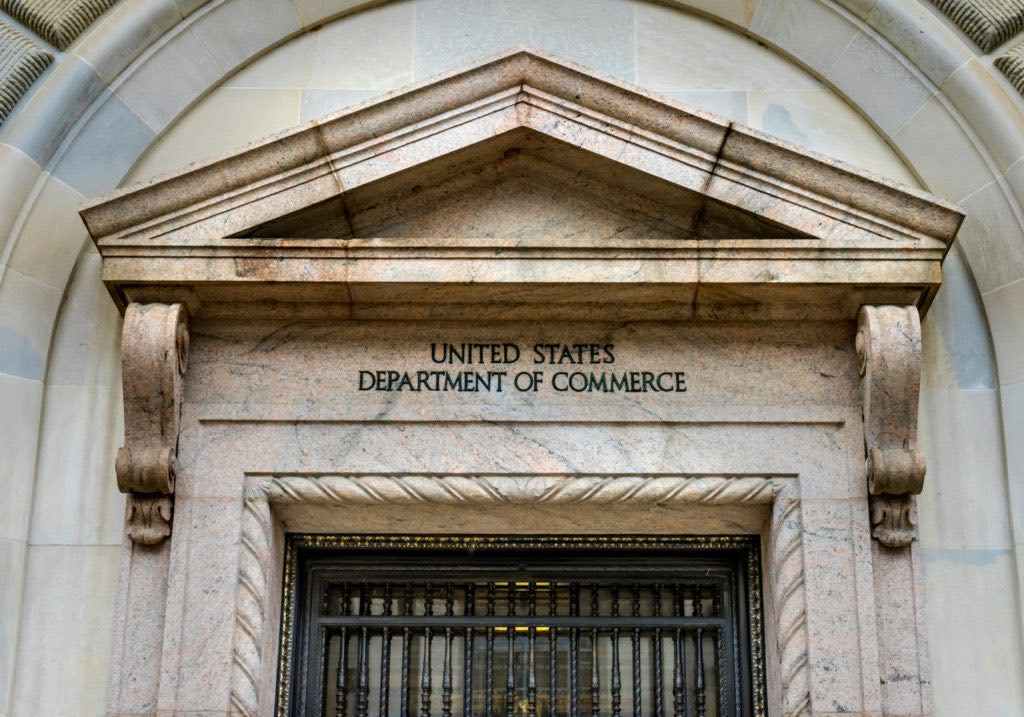
Remarks by Deputy Secretary of Commerce Don Graves at the Georgetown Business School Forum: Modern Industrial Strategy for U.S. Competitiveness, Equity, and Resilience
Nov 29, 2022
Remarks by Deputy Secretary of Commerce Don Graves at the Georgetown Business School Forum: Modern Industrial Strategy for U.S. Competitiveness, Equity, and Resilience
KCPullen@doc.gov
Tue, 11/29/2022 – 13:54
ICT Supply Chain
Infrastructure
Manufacturing
AS PREPARED FOR DELIVERY
Tuesday, November 29, 2022
Office of Public Affairs
publicaffairs@doc.gov
Don Graves
Good afternoon, everyone. It’s an honor to be back at Georgetown – my law school alma mater. I want to thank the McDonough School of Business for bringing us together for an important conversation on U.S. competitiveness and impact – in particular, impact on equity and resilience. This conference could not be timelier.
For the first time in decades, we have a generational opportunity to lay claim to the competitive industries of the future, along with the good-paying jobs and economic security that will come with them. But it’s going to require government, business, workers, and communities to work together in new and innovative ways, and it will require the private sector to consider national competitiveness and economic security as part of their corporate social responsibility.
Earlier this year, I traveled to Upstate New York to visit the Albany Nanotech Complex at the SUNY Polytechnic Institute—an advanced R&D facility, led by NY CREATES, a resource for public-private and academic partnerships. The facility specializes in commercialization projects, enabling access to semiconductor design and prototyping for startups, smaller businesses, and universities, as well as helping to attract investment for entrepreneurs.
Alongside this effort is SUNY’s Career Alignment Platform Initiative, partially funded by the Commerce Department. It provides students and workers with training and support through the Nanotech Complex, as well as strong university partnerships with Historically Black Colleges and Universities and other premier research universities, in order to access jobs in the chips industry. This ecosystem is laying the groundwork that will help to create hundreds of new chips companies and build a world class semiconductor workforce right here in the U.S.
The private semiconductor industry is taking notice: Micron Technology has already committed to build a semiconductor manufacturing complex – a chips cluster – in Syracuse. Now, being a Georgetown grad, I’m not normally one to tout Syracuse. But the ecosystem that Syracuse is building is impressive – and one of many examples we are seeing around the country.
This is how we will build back our industrial base and a strong middle class – not with silver bullets — but with government, business, educational institutions, and communities rolling up their sleeves and creating the conditions that will drive innovation, attract investment, and grow quality, middle-class jobs.
Far from picking a few winners or losers, modern American industrial strategy is about building ecosystems that enable more winners.
This is not how it has always been.
GOING BACK BEFORE GOING FORWARD
For years, policymakers pursued deregulation and tax cuts—rather than investments in industries, infrastructure, communities, and workers—as strategies for creating jobs and raising wages.
Their assumption was that a rising tide would lift all boats.
But instead, too many Americans were left behind.
For their part, corporations prioritized cost-savings and short-term gains, did not factor in risks to supply chains, and exported jobs abroad. Manufacturing employment fell, our industrial base was hollowed out, and we were saddled with supply chain bottlenecks.
Real wages decelerated and persistent inequality reached historically high levels.
Our workforce was left undertrained and saddled with rising childcare and education costs.
And then the COVID-19 pandemic, climate shocks, and Russia’s war of aggression against Ukraine laid bare our vulnerabilities. It became clear that this short-sighted approach to industrial competitiveness had left us less productive, less resilient, and less capable.
Even as we seek to address these vulnerabilities, our competitors and trading partners are not standing still. They are moving ahead with strategic public investments, along with private investments, in their own domestic manufacturing, including in semiconductors and other emerging tech.
Some are also using use unfair subsidies and dumping and becoming increasingly sophisticated at finding loopholes in our antidumping and countervailing duty laws.
Our adversaries are ever-more aggressive in their efforts to control supply chains that we rely on – including critical minerals – and expropriate critical technologies.
Put simply, they are playing by a different set of rules. The Biden-Harris Administration knew early on that if we stood still, we’d fall behind. The United States needed a new approach to meet the challenge of the moment.
BIDEN-HARRIS ADMINISTRATION APPROACH
That’s why we have taken bold steps to rebuild and invest in our industrial base, bolster our resilience to threats from adversaries and climate change alike, and chart a path to long-term growth.
Just like the construction of the first transcontinental railroad in the 19th century, our strategic investments in emerging technologies in the post-World War II era, and the development of the Interstate Highway System in the 1950s and 60s, the federal government, in partnership with businesses, workers, universities, and other stakeholders, is once again seizing a once-in-a-generation opportunity.
With the passage of the American Rescue Plan, the Bipartisan Infrastructure Law, the CHIPS and Science Act, and the Inflation Reduction Act – all major legislative accomplishments of its first two years – the Biden-Harris Administration is making transformational investments in manufacturing innovation, research and development, infrastructure, workforce training, and community development.
We’re focusing these public investments and leveraging private investment in key areas such as semiconductors and clean energy technologies where private industry, on its own, had not factored in our national and economic security interests. We are working with business not only on what they invest in, but in how they operate, encouraging ways of doing business that get the most out of our workforce through quality jobs and mitigate climate risks. The goal with all of this to enable the American private sector to do what it does best – innovate, scale, and compete.
DOC’S AGENDA IS AT THE HEART OF U.S. INDUSTRIAL STRATEGY
The Department of Commerce is playing a central role in the Administration’s industrial strategy to drive U.S. competitiveness, innovation, equity, and resilience. Our department’s agenda is focused on:
investing in manufacturing innovation, especially in areas critical to our national and economic security.
investing in our workforce and people; and
forging high-standards, strategic partnerships with allies abroad.
INVESTING IN MANUFACTURING AND INNOVATION
First, investments in manufacturing innovation in key sectors that are essential to rebuilding our industrial capabilities, economic resilience, and geostrategic advantage.
The bipartisan CHIPS and Science Act that President Biden signed into law in August provides $50 billion to the Commerce Department to revitalize our domestic semiconductor industry. We are administering this funding through our new CHIPS for America program.
The funding will drive R&D and manufacturing incentives that will facilitate domestic production of the most advanced chips and expand production of mature chips essential to our national and economic security.
Investing in chips will have spillovers across multiple sectors of the economy, from household appliances to defense capabilities, from the energy sector to transportation – all while driving innovation, enhancing productivity, and growing good paying jobs.
These investments will also foster local ecosystems across the country with a focus on local economic development and equity. As we help build out semiconductor clusters in communities across the country, we are enlisting producers, suppliers, and consumers as well as universities and research institutions. The goal is to foster conditions for these clusters to be more the norm than the exception.
Similar to CHIPS, under the Inflation Reduction Act, the Administration is making the largest-ever federal investment in clean energy innovation and leveraging private capital to scale clean technologies of the future—from electric vehicles to clean hydrogen to offshore wind. This is how we’ll reduce our dependence on volatile commodities, and protect against the costs of the climate crisis.
INVESTING IN OUR WORKFORCE AND COMMUNITIES
The second priority area is investing in our workforce to unlock the full potential of our country and people–including women, communities of color, as well as our rural and tribal communities. These investments are as important to our competitiveness as investments in roads, bridges, and domestic manufacturing.
We ignore this at our own peril. The Kellogg Foundation’s research, for instance, indicates that the U.S. economy could be $8 trillion dollars larger by 2050 if we eliminated racial disparities in health, education, incarceration, and employment.
We are deploying nearly $50 billion under the Bipartisan Infrastructure Law to bring affordable, reliable high-speed internet to every American, with a dedicated focus on equitable access.
We’ve also awarded $500 million in grants under the Good Jobs Challenge, under the American Rescue Plan, to support industry-led education and training opportunities.
We also recently announced that the Commerce Department’s Minority Business Development Agency—the only federal agency created specifically to foster the growth of minority-owned businesses in America– is teaming up with the Treasury Department to deploy $100 million in State Small Business Credit Initiative Technical Assistance funding. This program will help close the entrepreneurship gap in America by providing underserved entrepreneurs with the tools and skills to access capital and to access networks of support. Please stay tuned for more information.
“WHERE” WE INVEST IN INDUSTRIES AND COMMUNITIES MATTERS
For all these investments – in CHIPS, clean tech, high-speed internet, or the Good Jobs Challenge – where and how we invest matters a great deal. A key element of the equity agenda is ensuring that we are investing in all types of regions of the country – urban and rural, coastal and heartland – and leveraging the private sector to look for investment opportunities in places they may have overlooked in the past.
That is why a central feature of our industrial strategy investments is a place-based approach that seeks to leverage the competitive advantage of diverse communities and regions.
We’re building on the Commerce Department’s decades of experience as a center of excellence for economic development, clusters, and place-based initiatives to reduce geographic inequality. For instance, under the American Rescue Plan, the Commerce Department launched the billion dollar Build Back Better Regional Challenge to invest in a new kind of community development that supports business, labor, local government, and educational institutions, and leverages private capital.
The 21 awardees, announced in September by President Biden, will provide tens of thousands of workers with new skills to adapt to changing technology and access good jobs – from coal communities in West Virginia to Native communities in South Dakota, from biotech clusters in Oklahoma to a regional energy hydrogen hub in Louisiana. They’ll provide start-ups with funding to grow and become economic generators. And they’ll help research institutions become competitive enablers for regional economies.
EXPANDING OUR INTERNATIONAL ENGAGEMENT
The third priority area for the Commerce Department is enhancing and expanding our international engagements that benefit both our allies and our workers.
That means expanding export opportunities, including for women- and minority-owned businesses, and attracting foreign direct investment in strategic sectors like clean tech, semiconductors, international education, and agriculture.
The U.S.-EU Trade and Technology Council, the Quad, the Indo-Pacific Economic Framework for Prosperity, and the Americas Partnership for Economic Prosperity are all examples of strategic partnerships we are forging with partners around the world. With them, we are developing shared rules of the road and establishing high standards across trade, technology including AI, cybersecurity, climate action, workforce development, labor and environment, and anti-corruption.
We are also supporting high-standard infrastructure investments in Africa that in turn will create export opportunities for U.S. businesses.
These economic partnerships that raise standards with other our partners will forestall the race to the bottom on labor rights and environmental standards that characterized the era of globalization and outsourcing. They will also ensure that our companies have access to critical inputs and materials, and that supply chains are resilient and diversified. That means we will be better able to avoid factory furloughs and manage the costs of consumer goods.
THE PRIVATE SECTOR’S ROLE
As I mentioned at the outset, our national competitiveness and economic security is about more than what investments the public and private sectors are making in critical technologies. It also about how businesses operate–how they will innovate products and processes, strengthen their business models, assess and reduce their carbon footprints, and ensure their workplaces are diverse and inclusive and their employees are engaged.
From my conversations with CEOs and small business owners alike, I know that many of our companies understand this
They are aware, as a recent Gallup Poll reported, that only a third of workers say they are engaged in their work and workplace. Yet, businesses that prioritize their workforces outperform.
They know, as a McKinsey study noted, that executing environmentally sound strategies – in, for example, water, energy, and raw materials – can help combat rising operating expenses— by as much as 60 percent. And there is a strong correlation between resource efficiency and financial performance.
They also know that the business case for diversity, equity, inclusion and accessibility is stronger than ever. Study after study underscores that diverse leadership teams are associated with more and better innovation and better financial performance.
While some may unfairly question the relevance of ESG for value and the bottom-line, American businesses know better and want to be part of the solution.
For instance, on job quality, earlier this year, private sector leaders joined the Departments of Commerce and Labor for the launch of a set of Good Jobs Principles that cover recruitment and hiring, pay and benefits, job security and career advancement, collective bargaining rights, and working conditions.
On decarbonization, President Biden launched the First Movers Coalition—a public-private partnership to jumpstart the market for low-carbon technologies through advance purchase commitments. Today, the Coalition includes 65 companies, representing more than 10 percent of the global Fortune 2000, as well as ten government partners.
These are just two examples of the private sector pushing the frontier of ESG in ways that will make a difference for their business as well our national competitiveness. There are many more.
To the students here – you are the future leaders of American industry. So, today, as you discuss and debate the implications of our competitiveness efforts for ESG, and vice versa, I invite you to consider how industrial strategy—with its investments in strategic sectors like semiconductors and clean tech—will create new opportunities for American businesses and workers, and their ability to innovate. How should business leaders think about national competitiveness and economic security as part of corporate social responsibility? How can business work effectively with government to create the industries of the future, while protecting our national and economy security?
Where you come out on these questions and what you do about them will profoundly shape our economic future. We’re counting on you.
Thank you for inviting me to join you today. I’m looking forward to our discussion.
Leadership
Don Graves
Tags
CHIPS Act
Read the full report from the U.S. Department of Commerce: Read More



